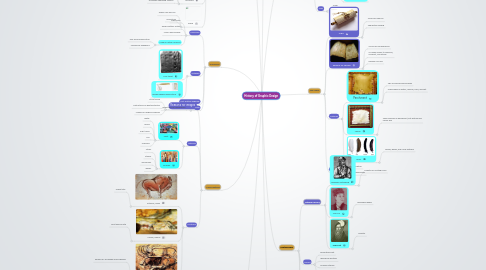
1. Cave Paintings
1.1. Reasons for images
1.1.1. Story telling
1.1.2. Instructions on hunting tactics
1.1.3. Magical or religious reasons
1.2. Materials
1.2.1. Paint
1.2.1.1. Water
1.2.1.2. Blood
1.2.1.3. Plant Juice
1.2.1.4. Soil
1.2.1.5. Charcoal
1.2.2. Brushes
1.2.2.1. Sticks
1.2.2.2. Stones
1.2.2.3. Animal hair
1.2.2.4. leaves
1.3. Locations
1.3.1. Altamira, Spain
1.3.1.1. Oldest site
1.3.2. Lasaux, France
1.3.2.1. Most famous site
1.3.3. Chauvet Pont D'arc
1.3.3.1. Known for 3D design and scrapings
2. Cuneiform
2.1. Sumerians
2.1.1. Theocratic
2.1.2. Skilled Pottery Artists
2.1.3. Music was valuable
2.1.4. Lived in Fertile Crescent
2.1.4.1. Year around agriculture
2.1.4.2. Invaded by Akkadians
2.2. Materials
2.2.1. Clay tablet
2.2.2. Wedge shaped weed stylus
2.3. First written language
2.4. Uses
2.4.1. Keep track of transactions
3. Photography
3.1. History
3.1.1. Camera Obscura
3.1.1.1. "Dark Chamber"to view light
3.1.2. Daguerreotype
3.1.2.1. Daguerre
3.1.2.1.1. Practical Photo process
3.1.3. Calotype
3.1.3.1. William Fox
3.1.3.1.1. Image exposed to create a paper negative
3.1.3.1.2. fuzzier, but duplicates possible
3.1.4. Wet Plate Process
3.1.4.1. Archer
3.1.4.1.1. Exposed for three seconds onto collodion glass plates
3.1.4.1.2. had to be exposed while still wet
3.1.5. Dry Plate Process
3.1.5.1. Richard Madox
3.1.5.1.1. glass plates coated with gelatin
3.1.5.1.2. prevented drying
3.1.6. Eastman modification
3.1.6.1. Eastman
3.1.6.1.1. uses roll film to replace glass
3.1.6.1.2. use by general public
3.1.7. Color Photography
3.1.7.1. James Clerk Maxwell
3.1.8. Instant Photography
3.1.8.1. Edwin Land
3.1.9. zoopraxiscope
3.1.9.1. Muybridge
4. Computers
4.1. People
4.1.1. Konrad Zuse
4.1.1.1. First Freely programmable Computer
4.1.2. Howard Riken and Grace Hopper
4.1.2.1. MARK
4.1.2.1.1. Navy
4.1.3. John Preseper Eckert and John Mauchly
4.1.3.1. UNIVAC
4.1.3.1.1. Commercial computer
4.1.4. Douglas Engelbart
4.1.4.1. Computer mouse
4.1.5. Robert Metcalfe
4.1.5.1. ethernet
4.2. Companies
4.2.1. IBM
4.2.1.1. Fortram: high level programming language
4.2.1.2. IBM701 EDP
4.2.1.3. Floppy Disk
4.2.2. Intel
4.2.2.1. Intel 4004: Single chip microprocessor
4.2.3. Xerox
4.2.3.1. GUI: Graphical User Interface
4.2.4. Microsoft
4.2.4.1. PC: Personal Computer
4.2.4.2. MS-DOS
4.2.4.3. WIndows Operating System
4.2.5. Apple
4.2.5.1. Apple Lisa: has GUI
4.2.5.2. Macintosh
5. Hieroglyphics
5.1. Orgin
5.1.1. Likely Cuneiform
5.1.2. Combination of logo graphic and alphabetic elements
5.2. Egyptians
5.2.1. Priests and Priestesses were literate
5.2.1.1. Wrote Books of Dead
5.2.1.2. Created The Rosetta Stone
5.2.1.2.1. Contained Egyptian Hieroglyphics, Demotic, and Greek
5.3. Uses
5.3.1. Religion
5.3.2. Battle communication
5.3.3. Government
5.4. Materials
5.4.1. Papyrus
5.4.1.1. Dried, layered, and flattened reeds
6. Phoencians
6.1. Orgin
6.1.1. Variation of Hieroglyphics
6.1.2. Ties with Cuneiform
6.1.3. Independent language
6.2. Successes
6.2.1. One sign represents a spoken sound
6.2.2. Writing from right to left (in straight lines)
6.2.3. Easily adaptable to other languages
6.2.4. Disintegrated class divisions
6.3. Greek adaptations
6.3.1. Created vowels
6.3.1.1. Latin Alphabet
6.3.2. Two writing styles
6.3.2.1. Rigid and formal
6.3.2.2. quick and informal
6.3.3. Serifs
6.3.3.1. an aesthetic finishing-off hook
6.3.4. baselines
6.4. Uses
6.4.1. Trade
6.4.2. Communication
7. The Codex
7.1. Orgin
7.1.1. Scrolls of Papyrus
7.1.2. Sequential reading
7.2. Reasons for Change
7.2.1. Scrolls are cumbersome
7.2.2. A Codex is easy to refrence, compact, and sturdy
7.2.3. Random Access
7.3. Materials
7.3.1. Parchment
7.3.1.1. Skin of animals was cleaned
7.3.1.2. Hide soaked in water, calcium, flour, and salt
7.3.2. Vellum
7.3.2.1. Same process as parchment, but with young calves skin
7.3.3. Quills
7.3.3.1. Turkey, geese, and Crow feathers
7.4. Uses
7.4.1. Bibles and Scripture
7.4.2. Illuminated manuscripts
8. Printing Press
8.1. Notable Persons
8.1.1. Johannes Gutenberg
8.1.1.1. Inventor of Printing Press
8.1.2. Ts'ai Lun
8.1.2.1. developed paper
8.1.3. John Fust
8.1.3.1. Investor
8.2. Impact
8.2.1. Perfected script
8.2.2. rapid book printing
8.2.3. Increase literacy
8.2.4. Information shared lead to Renaissance
8.3. Materials
8.3.1. Movable Type
8.3.1.1. made of a lead, tin, and antimony alloy
8.3.2. matrix
8.3.2.1. hard metal punch that is hammered into a softer copper bar
8.3.3. oil-based ink
8.4. Current printing process
8.4.1. Relief Printing
8.4.2. Intaglio
8.4.3. Porous
8.4.4. Lithography
9. Linotype
9.1. Notable Persons
9.1.1. Clephane
9.1.1.1. Stenographer who encouraged creation of typewriter
9.1.2. Christopher Sholes
9.1.2.1. Creates commercial typewriter
9.1.3. Ottmar Mergenthaler
9.1.3.1. Creates Linotype
9.2. Parts
9.2.1. Keys
9.2.1.1. White, blue, and black
9.2.2. matrix
9.2.2.1. mold for letter forms
9.2.3. slug
9.2.3.1. The assembled line of type
9.2.4. space band
9.2.4.1. creates justified text
